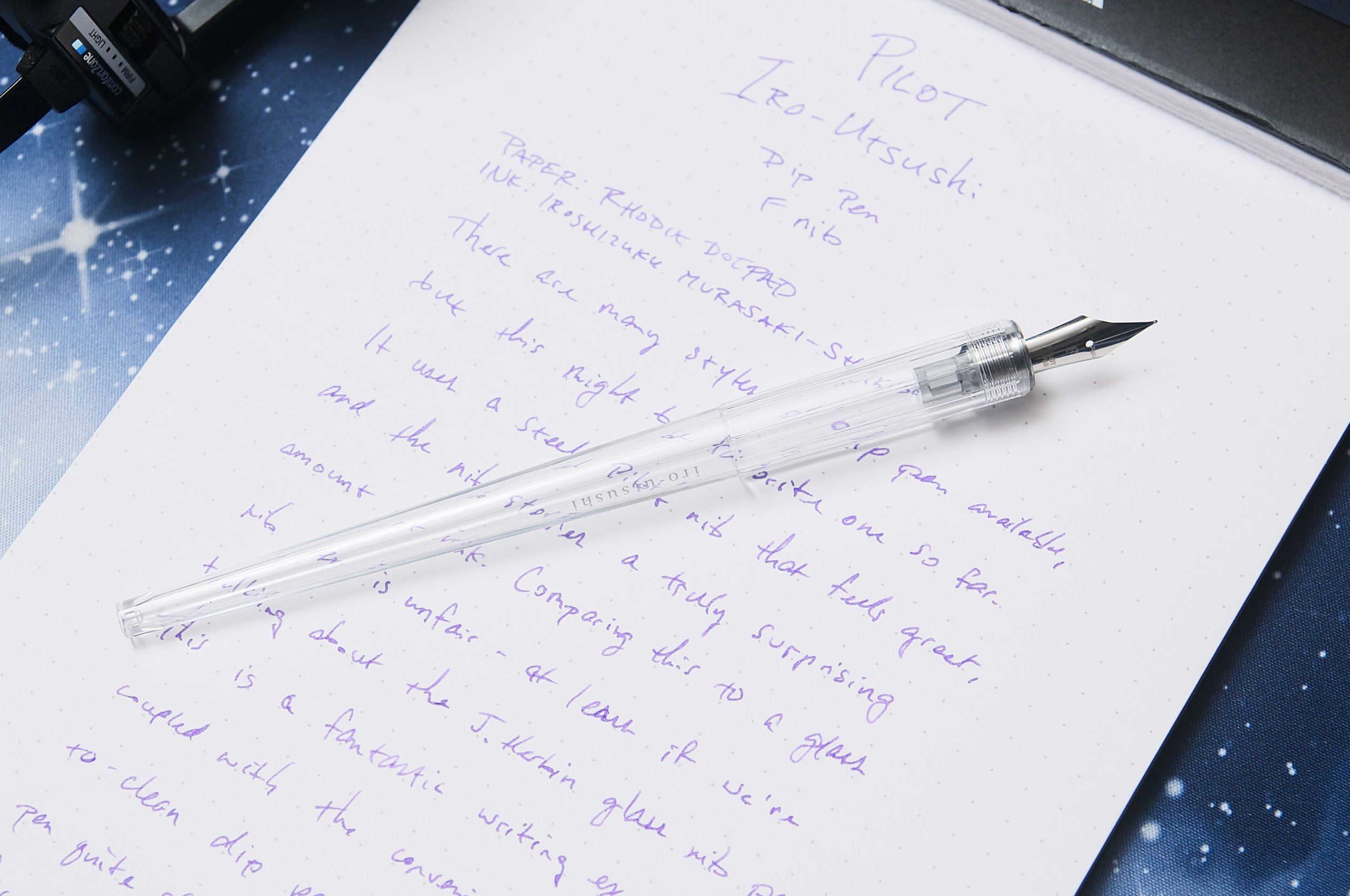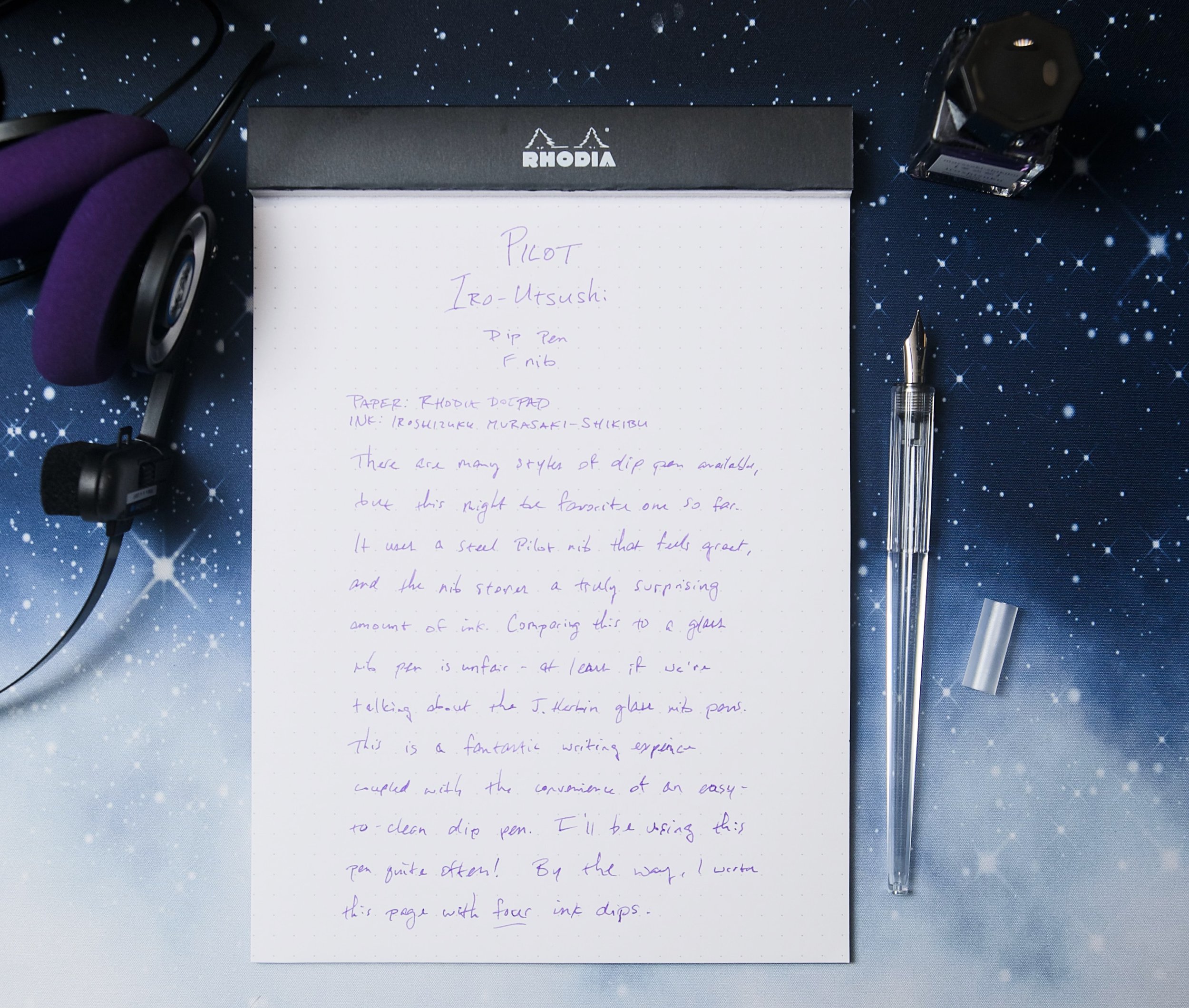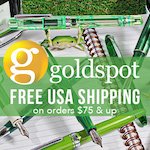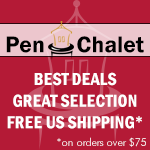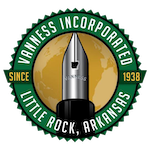(Jeff Abbott is a regular contributor at The Pen Addict. You can find more from Jeff online at Draft Evolution and Twitter.)
I've tried several different types of dip pens over the years, but none of them have really stuck with me. They're either too fiddly or messy, or they feel so different from a fountain pen that I prefer to just ink up a fountain over rather than use the dip pen. I was intrigued when I saw that Pilot offers an entry-level dip pen that uses a familiar nib, so I had to try it out.
The Pilot Iro-Utsushi dip pen is a relatively low cost dip pen that features one of Pilot's stainless steel nibs — the same nib you'll find on a Pilot Metropolitan, for example. My hopes weren't very high, because I assumed that even if the nib felt just like a Metropolitan or other Pilot pen, it would be too much hassle to use given the limited ink supply. The other dip pens I've used in the past have some sort of primitive system to store little pockets of ink in the nib, but this Pilot looks like an ordinary nib that you'll find attached to a feed and ink reservoir system. Well, I'm delighted to say that my assumptions were wrong.
Even though the nib on the Iro-Utsushi is the same nib you'll find on many of Pilot's entry-level fountain pens, it does a surprisingly good job of holding a good amount of ink. I've used dip pens in the past, and I'm used to much less ink supply and needing to dip much more frequently. Dipping the nib past the breather hole provides enough ink to write a couple sentences. If you dip a little further and submerge most of the nib shoulders into the ink, you can get a couple more sentences out of it. I was genuinely surprised that I could write for as long as I was able with each dip.
Another problem I've always had with dip pens is that the ink flow varies drastically with a fresh dip versus when the ink is almost gone. After dipping the pen, the ink just gushes and almost makes a mess, and the flow continues to decrease until the ink is gone. This isn't a problem with the Iro-Utsushi. The ink flow is consistent even after dipping the nib, and it remains consistent right up until it runs out of ink. You can start to see the ink flowing a little lighter, and that means there's only enough ink left for a couple of characters. Again, this surprised me in such a good way.
Regardless of the type of dip pen you're using, there's one constant: they are ridiculously easy to clean. The Iro-Utsushi is no exception. Run the inky nib under some water and wipe it dry. That's it! Within a few seconds, you're ready to try out another ink. This is a fantastic method for trying out several inks without committing to filling up a pen and the eventual cleaning that entails.
The fine nib on this unit is smooth flowing and makes a crisp line that is comparable to my other Pilot steel fine nibs. The barrel is made of thin plastic, and the only non-plastic part of the pen is the nib, which is wedged into the front of the pen with friction. It's actually fairly difficult to remove the nib, so I have no concerns about the nib accidentally falling off into a bottle of ink. Being so lightweight, it's also incredibly easy to control the movement of the pen, though I did find myself wishing it was just a bit thicker to provide a more comfortable grip.
There isn't a cap provided with the pen, except for a small section of silicone tubing that is on the nib while it's in the box. I've kept the little piece to use on the pen when not in use. It's not much, but it does offer some protection for the nib when it's stored away with other objects. I'd like to design a simple cap that I can 3D print — something that both protects the nib and also provides a flat edge to keep the pen from rolling around when it's on a flat surface. For now, the little section of tubing is at least protecting the nib!
The Pilot Iro-Utsushi dip pen is just $8 at Vanness. Compared to other dip pens, this is very competitive, and I'd argue that it's also the best first-time experience you can have with dip pens. Glass pens feel too different and it's not really fair to compare them with traditional metal nibs. Other dip pens that use metal nibs aren't really the same as fountain nibs either. They're either catering to calligraphy use or for artists — which means they don't work particularly well for general writing, nor do they offer a good comparison to the fountain pen nibs you're likely already accustomed to. For me, this is the best dip pen experience I've tried so far.
I know there are plenty of others that I haven't had an opportunity to try, but it's hard to beat the Iro-Utsushi on price. I picked the clear body, but it's also available in a light blue or gray (both translucent) plastic, or a light or dark wood nib holder (the wood versions are $20). You also have your pick of fine or medium nib. Regardless of barrel and nib choice, I highly recommend checking these out if you're even remotely interested in dip pens! The ability to quickly try out inks without the mess of cleaning out a pen is incredibly convenient.
(Vanness Pens provided this product at a discount to The Pen Addict for review purposes.)
Enjoy reading The Pen Addict? Then consider becoming a member to receive additional weekly content, giveaways, and discounts in The Pen Addict shop. Plus, you support me and the site directly, for which I am very grateful.
Membership starts at just $5/month, with a discounted annual option available. To find out more about membership click here and join us!


